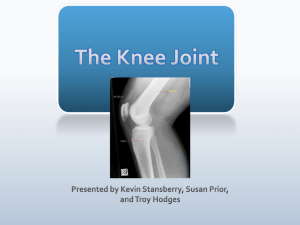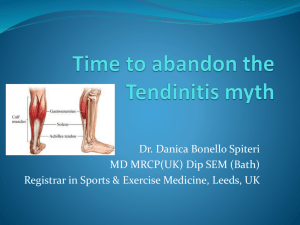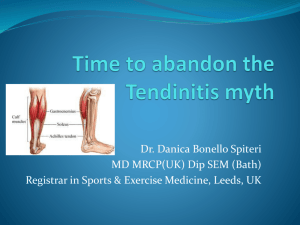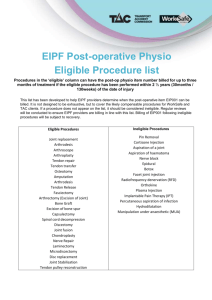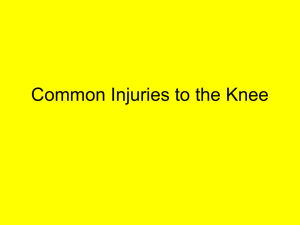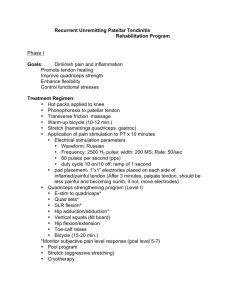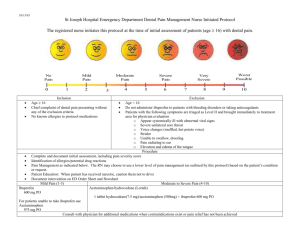American Journal of Sports Medicine
advertisement
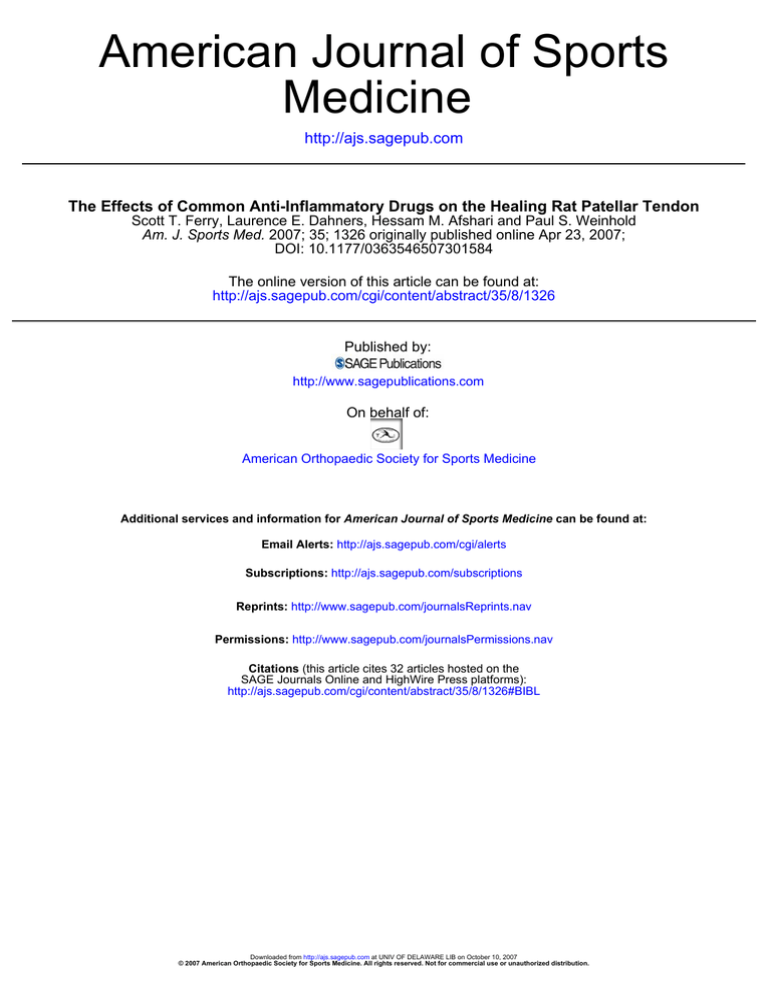
American Journal of Sports Medicine http://ajs.sagepub.com The Effects of Common Anti-Inflammatory Drugs on the Healing Rat Patellar Tendon Scott T. Ferry, Laurence E. Dahners, Hessam M. Afshari and Paul S. Weinhold Am. J. Sports Med. 2007; 35; 1326 originally published online Apr 23, 2007; DOI: 10.1177/0363546507301584 The online version of this article can be found at: http://ajs.sagepub.com/cgi/content/abstract/35/8/1326 Published by: http://www.sagepublications.com On behalf of: American Orthopaedic Society for Sports Medicine Additional services and information for American Journal of Sports Medicine can be found at: Email Alerts: http://ajs.sagepub.com/cgi/alerts Subscriptions: http://ajs.sagepub.com/subscriptions Reprints: http://www.sagepub.com/journalsReprints.nav Permissions: http://www.sagepub.com/journalsPermissions.nav Citations (this article cites 32 articles hosted on the SAGE Journals Online and HighWire Press platforms): http://ajs.sagepub.com/cgi/content/abstract/35/8/1326#BIBL Downloaded from http://ajs.sagepub.com at UNIV OF DELAWARE LIB on October 10, 2007 © 2007 American Orthopaedic Society for Sports Medicine. All rights reserved. Not for commercial use or unauthorized distribution. The Effects of Common Anti-Inflammatory Drugs on the Healing Rat Patellar Tendon Scott T. Ferry, MD, Laurence E. Dahners, MD, Hessam M. Afshari, and Paul S. Weinhold,* PhD From the Department of Orthopaedic Surgery, University of North Carolina, Chapel Hill, North Carolina Background: Tendon injuries that occur at the osteotendinous junction are commonly seen in clinical practice and range from acute strain to rupture. Nonsteroidal anti-inflammatory drugs are often prescribed in the treatment of these conditions, but the effect that these agents may have on the healing response at the bone-tendon junction is unclear. Hypothesis: In response to an acute injury at the osteotendinous junction, the healing patellar tendon will have inferior biomechanical properties with administration of anti-inflammatory drugs as compared with acetaminophen and control. Study Design: Controlled laboratory study. Methods: A total of 215 Sprague-Dawley rats underwent transection of the patellar tendon at the inferior pole of the patella, which was subsequently stabilized with a cerclage suture. The animals were then randomized into 7 groups and administered 1 of the following analgesics for 14 days: ibuprofen, acetaminophen, naproxen, piroxicam, celecoxib, valdecoxib, or control. At 14 days, all animals were sacrificed, and the extensor mechanism was isolated and loaded to failure. Biochemical analysis of the repair site tissue was performed. Animal activity throughout the study was monitored using a photoelectric sensor system. Results: The control group demonstrated greater maximum load compared with the celecoxib, valdecoxib, and piroxicam groups (P < .05). The acetaminophen and ibuprofen groups were also significantly stronger than the celecoxib group (P < .05) but not statistically different than the control group. A total of 23 specimens had failure of the cerclage suture with the following distribution: control (0/23), ibuprofen (0/23), acetaminophen (0/24), naproxen (3/24), piroxicam (4/24), celecoxib (6/22), and valdecoxib (10/24). The difference in distribution of the failures was significant (P < .001). Conclusions: Anti-inflammatory drugs, with the exception of ibuprofen, had a detrimental effect on healing strength at the bonetendon junction as demonstrated by decreased failure loads and increased failures of the cerclage suture. Acetaminophen had no effect on healing strength. The biomechanical properties paralleled closely with the total collagen content at the injury site, suggesting that these agents may alter healing strength by decreasing collagen content. Clinical Relevance: Selective and nonselective cyclooxygenase (COX) inhibitors should be used judiciously in the acute period after injury or surgical repair at the bone-tendon junction. Keywords: tendon repair; analgesics; NSAID; cyclooxygenase (COX) Tendon injuries at the bone-tendon junction are frequently encountered in both general and orthopaedic clinical practice. Commonly seen entities in the upper extremity are mallet finger, jersey finger, biceps tendon rupture, pectoralis major rupture, and rotator cuff tear. Injuries at the osteotendinous junction are also seen in the lower extremity in the form of patellar tendon rupture, quadriceps tendon rupture, and insertional Achilles rupture. These injuries are disabling and typically painful, often leading to use of some type of analgesic in their management. Many of these injuries also have improved results with surgical management, necessitating some form of postoperative analgesia. Commonly prescribed analgesics for these types of injuries include acetaminophen, nonselective nonsteroidal antiinflammatory drugs (NSAIDs), cyclooxygenase-2 (COX-2) selective NSAIDs, and opiates. In the literature, there is a vast amount of animal data investigating the effect of both nonselective and COX-2 *Address correspondence to Paul S. Weinhold, PhD, University of North Carolina, Orthopaedic Research Labs, 134 Glaxo Biotechnology Building CB#7546, 101A Mason Farm Road, Chapel Hill, NC 27599-7546 (e-mail: weinhold@med.unc.edu). Presented at the interim meeting of the AOSSM, Chicago, Illinois, March 2006. One or more of the authors has declared a potential conflict of interest: 2 authors have received funds for research, and 3 authors have received funds for employee salaries. The American Journal of Sports Medicine, Vol. 35, No. 8 DOI: 10.1177/0363546507301584 © 2007 American Orthopaedic Society for Sports Medicine Downloaded from http://ajs.sagepub.com at UNIV OF DELAWARE LIB on October 10, 2007 © 2007 American Orthopaedic Society for Sports Medicine. All rights reserved. Not for commercial use or unauthorized distribution. 1326 Vol. 35, No. 8, 2007 Effects of Common NSAIDs on Healing Rat Patellar Tendons selective NSAIDs on bony healing.3,4,10,15,17,18,26,27 Both categories of these agents clearly appear to have a negative effect on bony healing in the form of decreased biomechanical strength, slower radiographic healing, and delayed fracture callus maturation. This effect is not seen with acetaminophen.4 The data concerning the effects of NSAIDs and other analgesics on tendon healing are more limited, and the effects on healing remain unclear. Previous studies have examined the effects that NSAIDs have on tendon healing. This has been accomplished primarily with in vitro tenocyte cultures and in vivo animal studies.1,8,14,25,29,30 Several in vivo studies have shown a negative effect when NSAIDs are given postoperatively after tendon transection. Cohen et al8 demonstrated decreased failure loads and increased rates of failure in surgically repaired rat supraspinatus tendons of animals given indomethacin or celecoxib compared with controls. Virchenko et al30 also demonstrated decreased failure loads in parecoxib-treated rats that underwent transection of the Achilles tendon. The purpose of this study was to compare the effects of a number of commonly used analgesic agents on the properties of a healing tendon at the osteotendinous junction. Although other studies have investigated the effects of 1 or 2 medications, to the best of our knowledge, this is the first to directly compare 6 different medications and a control. It was our hypothesis that the acute inflammatory response seen after acute injury or surgery is important to the healing process and that the administration of either nonselective or COX-2 specific NSAIDs in the immediate postoperative period will have detrimental effects compared with control. As acetaminophen lacks these anti-inflammatory properties, we would not expect to see detrimental changes with postoperative use. MATERIALS AND METHODS Animal Care and Procedures Protocols were approved by the university Institutional Animal Care and Use Committee. A total of 215 retired breeder female Sprague-Dawley rats weighing between 350 and 500 g were obtained from a commercial breeder. Seven different study groups were used—6 receiving different analgesic agents and the final group serving as a control. Animals were allowed a 2-day acclimation period before undergoing any procedures. Animals were anesthetized with isoflurane, and the hair overlying the left anterior knee was removed using electric clippers. The skin was prepared, and a 10-mm longitudinal incision was made over the anterior aspect of the knee to expose the patellar tendon. The tendon was then transected sharply at the inferior pole of the patella using a No. 11 blade scalpel. The medial and lateral retinacula were left intact. After tendon transection, a 2-0 Ethibond suture (Ethicon Inc, Johnson & Johnson, Somerville, NJ) was used for stabilization. The tendon ends were reapproximated using a cerclage technique. The suture was passed through the proximal tibia in a medial to lateral fashion using the needle to drill its own passage. The stitch was then passed through the quadriceps tendon in a lateral 1327 to medial direction and tied on the medial side. Tension was set on the suture to maintain approximation of the tendon ends at 120° of knee flexion. The skin was then closed with two 3.0 Vicryl (Ethicon) sutures. The animals were returned to their cages and allowed food, water, and activity ad libitum. Drug Administration Rats were divided into the following daily drug dosage groups: acetaminophen (60 mg/kg), ibuprofen (30 mg/kg), piroxicam (2.5 mg/kg), naproxen (24 mg/kg), celecoxib (10 mg/kg), and valdecoxib (3 mg/kg). The seventh group served as control. Dosages were similar to previous studies evaluating the effect of NSAIDs on rat soft tissue healing, fracture healing, and analgesia.4,6,9,11,16,22 Ibuprofen dosage was determined based on a previous rat study evaluating the effects of ibuprofen on fracture healing.3 The dosage of valdecoxib was obtained from previous rat studies demonstrating a maximum analgesic effect at the 3 mg/kg/d dose.2 Study analgesics were administered to the rats via rat chow. Previous studies have demonstrated that rats consume approximately 55 g/kg of food per day.11 Using this value, rat chow was prepared by Purina Test Diets (Purina Mills, Richmond, Ind) at a concentration to achieve the above drug dosages per day. A control test diet with no supplemental drug was also obtained from Purina. Total food consumed throughout the study period for each animal was recorded to ensure that adequate study medication was consumed. Using the standard value for food consumption of 55 g/kg/d, animals were excluded if they consumed less than 70% (38 g/kg/d) of the expected amount, averaged over the study period. Animals were randomized to treatment group at the conclusion of the surgical procedure by selecting colored cards from an envelope. The card color was used to identify the correct food after surgery and for feeding purposes throughout the study. The investigators were blinded to the analgesic agent linked to the color throughout the study. Activity Monitoring Because exercise has been shown to have effects on soft tissue healing, an attempt was made to quantify the activity between each treatment group. In attempts to perform this task in a cost-efficient manner, we devised a system of activity monitoring using photoelectric sensors. A similar system was previously described for mouse activity monitoring with infrared sensors.19 The rats were housed in individual cages with the water source on one end and food on the other end. The photoelectric sensor (Q14, Banner Engineering, Minneapolis, Minn) was set up to bisect the midportion of the cage between the food and the water. The sensors were linked to a control module (Logo!, Siemens Energy and Automation, Alpharetta, Ga) that recorded a count each time the beam was crossed. The beam was set at a height near the top third of the rat in an attempt to decrease incidental multiple crossings by the feet or tail of the animals. One count was recorded each time the animal stepped into and subsequently out of the beam with a 1-second delay. Total counts were recorded at 24-hour intervals for the first Downloaded from http://ajs.sagepub.com at UNIV OF DELAWARE LIB on October 10, 2007 © 2007 American Orthopaedic Society for Sports Medicine. All rights reserved. Not for commercial use or unauthorized distribution. 1328 Ferry et al The American Journal of Sports Medicine 7 days postoperatively. In the initial group monitored (36 animals), activity counts were only recorded postoperatively. Monitored animals in the initial group were evenly distributed between all 7 groups. In the final group monitored (12 animals), activity counts were recorded for 5 days preoperatively and 7 days postoperatively. The animals in this group were evenly distributed between control, acetaminophen, ibuprofen, and celecoxib. Only 4 groups were studied, to increase the numbers per group. These 4 were selected using the initial biomechanical results based on representative groups (control, acetaminophen, and celecoxib) and the NSAID group that did not have similar biomechanical effects to other NSAIDs (ibuprofen). the tissue was thawed for 1 hour at room temperature and dehydrated. Dry weight was recorded, and the tissue was then subjected to papain digestion at 60°C for 6 hours.21,23 The digest was used for the determination of collagen and proteoglycan content. Collagen content of the digest was measured by hydroxyproline concentration by the method of Bergman and Loxley5 with a plate reader. Standard curves were created using known concentrations of hydroxyproline (Sigma-Aldrich, St Louis, Mo). Proteoglycan content was quantified by the dimethylmethylene blue assay procedure.12 Samples were analyzed with a plate reader. Sulphated glycosaminoglycan concentration was deduced from standard curves developed from known concentrations of chondroitin sulfate from shark cartilage (Sigma-Aldrich). Specimen Preparation Histology All animals were sacrificed by carbon dioxide overdose at 14 days. Both of the hind limbs were disarticulated at the hip, placed in saline-soaked gauze, and stored at –20°C until the time of mechanical testing. On the day of biomechanical testing, the hind limbs were allowed to thaw at room temperature for 1 hour. Dissection was then carried out under 1.5× magnification. The quadriceps, patella, patellar tendon, and tibia were isolated and dissected free of other soft tissues. The extensor retinaculum of the knee was also removed, using the visible edges of the patellar tendon as a landmark. Mechanical Testing The length of the tendon as viewed from the anterior surface from the distal pole of the patella to the tibial insertion was measured using a digital micrometer. Measurements were taken in triplicate and averaged. The cross-sectional area of the tendon at the repair site was also measured using an area micrometer under 0.12 MPa of compression. Measurements were taken in triplicate and averaged. After dissection and measurement, the tibia was secured in a custom grip on a servohydraulic testing machine (Instron 8500, Instron, Canton, Mass). The quadriceps muscle and tendon were secured in a custom-designed cryogrip.24 The tendon was preloaded to 0.5 N, and the quadriceps–patella–patellar tendon–tibia complex was loaded to failure at a constant deformation rate of 0.08 mm/s, corresponding to a 1% strain rate per second. A single operator performed all biomechanical testing, and the failure site was recorded. The loaddeformation data were acquired via an analog-to-digital converter linked to a personal computer. Using these data, the material properties of ultimate stress, strain at ultimate stress, elastic modulus by linear regression between load limits of 25% to 75% of ultimate load, and strain energy density to ultimate load were determined. In addition, the corresponding structural properties of maximum load, stiffness, and energy absorbed until ultimate load were determined. Biochemical Analysis After the biomechanical testing, the tissue at the injury site was harvested and stored at –20°C. At the time of testing, The final 35 animals in the study were used for histologic examination. There was an even distribution among the 7 groups. Immediately after sacrifice, the extensor mechanism was dissected free. The insertion of the patellar tendon off the tibia was sharply elevated with a No. 11 scalpel, and the quadriceps muscle and tendon were detached, leaving the patella and patellar tendon. This was then placed into 10% neutral buffered formalin and sent to a commercial histology laboratory for processing. The specimens were fixed, decalcified, and embedded in paraffin. Two longitudinal sections 200 µm apart were cut from each specimen. These were subsequently mounted and stained with hematoxylin and eosin. Sections were qualitatively evaluated for differences in cellularity, vascularity, organization, or inflammatory cell presence to determine if a more detailed quantitative assessment would be useful. Statistical Analysis Data were evaluated using a statistical analysis program (SigmaStat Version 3.0, SPSS Inc, Chicago, Ill). A 1-way analysis of variance was performed to evaluate if differences existed between any groups for weight, food consumption, activity, and biomechanical properties. If significant differences existed, it was followed by Holm-Sidak multiple comparison testing. Biochemical parameters were compared in an identical fashion to above. Data for failure site and cerclage failure were evaluated using a χ2 analysis. A power analysis before the study determined that 19 specimens were needed per group to demonstrate a 20% difference in biomechanical parameters assuming a 25% standard deviation, a power of .80, and α of .05. RESULTS A total of 215 rats were involved in the study. The first group of the study included 180 rats. These animals were used for biomechanical and biochemical analyses. Of these specimens, 16 were excluded for the following reasons: death (n = 2), infection (n = 7), inadequate food intake (n = 6), and tibial shaft fracture during testing (n = 1). Of the remaining 164 specimens, 23 had failure of the cerclage suture with Downloaded from http://ajs.sagepub.com at UNIV OF DELAWARE LIB on October 10, 2007 © 2007 American Orthopaedic Society for Sports Medicine. All rights reserved. Not for commercial use or unauthorized distribution. Vol. 35, No. 8, 2007 Effects of Common NSAIDs on Healing Rat Patellar Tendons Distribution of Cerclage Failures 1.40 30 1329 Normalized Activity vs Group 1.20 25 1.00 20 0.80 15 0.60 10 0.40 5 0.20 0 n ib xe ox e c le C o pr a N m r Pi n tr ca i ox ol on C he p no i am et en ib of r up Ib 0.00 ox c de Day 1 l Va Celecoxib Ibuprofen Ac Failed Cerclage Intact Cerclage Figure 1. The distribution of cerclage failures between treatment groups was significantly different (χ2 P < .001). Average Daily Counts vs Analgesic 500 400 Counts 300 200 100 Day 1 CELECOXIB CONTROL VALDECOXIB Day 3 Day 7 NAPROXEN ACETAMINOPHEN PIROXICAM IBUPROFEN Day 3 0 Figure 2. No significant differences were seen in postoperative activity counts between groups. extensive gap formation at the injury site. The distribution of cerclage failure is shown in Figure 1. The distribution of cerclage failures among the groups was significantly different. Celecoxib and valdecoxib had cerclage failure rates of 27% and 42%, respectively, compared with 0% for acetaminophen, ibuprofen, and control. The specimens with cerclage failure were markedly elongated, with fragile repair tissue. We believe that their frailty and markedly different dimensions from specimens that did not have cerclage failure may affect the validity of the results; therefore, the specimens with cerclage failure were not included in the biomechanical analysis. No significant differences were seen in average daily activity counts at 1, 3, or 7 days postoperatively for the 48 animals based on postoperative data only (Figure 2). For the 12 animals with both preoperative and postoperative activity counts, there was a significant decrease in the Day 7 Acetaminophen Control Figure 3. No significant differences were seen at 1, 3, or 7 days postoperatively in the percentage of activity compared with preoperative levels. postoperative counts compared to preoperative levels but no difference in the percentage of retained preoperative activity at 1, 3, or 7 days after surgery (Figure 3). The initial body weight, average daily food consumption, and change in body weight are shown in Table 1. There was a significant difference in the mean body weight change between the control and piroxicam groups. Biomechanical analysis was completed on 141 pairs of limbs. Although there appeared to be a higher proportion of failures away from the injury site in the acetaminophen, control, and ibuprofen groups, there were no statistically significant differences in failure site between groups (P = .143) (Table 2). Uninjured specimens typically fail off of the tibia, so a higher proportion of failures in this region is suggestive of complete healing at the injury site. The mean ultimate load for the injured and uninjured limbs is shown in Figure 4. For the injured limbs, the control group was significantly stronger than celecoxib (P = .002), piroxicam (P = .027), and valdecoxib (P = .033). In addition, celecoxib was significantly weaker than acetaminophen (P = .005) and ibuprofen (P = .009). There was no significant difference in mean ultimate load between the control group and acetaminophen, naproxen, or ibuprofen. The structural and material properties of ultimate strain, ultimate stress, stiffness, energy to ultimate load, and cross-sectional area are shown for the injured limbs in Table 3 and for the uninjured limbs in Table 4. The ultimate stress of the control group was significantly stronger than piroxicam, celecoxib, and valdecoxib (P < .05). There were no significant differences in stiffness, energy to ultimate load, failure site, or cross-sectional area. For the injured limbs, the mean patellar tendon lengths of the control, ibuprofen, and acetaminophen groups were all significantly less than that of the naproxen (P < .05) and valdecoxib (P < .05) groups (Table 3). In addition, the acetaminophen group had significantly shorter tendon length then the piroxicam group (P < .01). There were no significant differences in the biomechanical properties of the uninjured limbs. Downloaded from http://ajs.sagepub.com at UNIV OF DELAWARE LIB on October 10, 2007 © 2007 American Orthopaedic Society for Sports Medicine. All rights reserved. Not for commercial use or unauthorized distribution. 1330 Ferry et al The American Journal of Sports Medicine TABLE 1 Body Weight and Food Consumptiona Drug TABLE 2 Failure Site During Testing for Operative Limba Mean Initial Body Weight Food Consumption Body Weight (g) Change (g) (g/kg/d) Celecoxib Naproxen Piroxicam Control Acetaminophen Ibuprofen Valdecoxib 381.8 411.2 400.6 392.1 396.8 397.7 394.3 ± ± ± ± ± ± ± 31.5 37.3 36.3 42.3 33.2 35.3 42.8 4.6 –3.1 –13.4 13.9 -5.3 2.0 3.7 ± ± ± ± ± ± ± 32.4 25.2 27.2b 37.6 18.7 19.2 20.6 67.6 61.6 57.3 65.3 61.0 62.3 60.6 ± ± ± ± ± ± ± 15.1 11.5 11.7 8.8 8.1 7.4 9.0 Drug Injury Midsubstance Tibial Insertion 14 17 18 16 13 18 12 1 0 0 0 1 0 0 1 3 2 7 10 5 2 Celecoxib Naproxen Piroxicam Control Acetaminophen Ibuprofen Valdecoxib a No significant differences between groups. a All values reported as mean ± standard deviation. b Significantly different vs control (P < .05). Ultimate Load 160 DISCUSSION Animal studies evaluating the biomechanical effects of anti-inflammatory medications on tendon repair have been undertaken since the 1970s. The results of investigations over the last 30 years have rendered some conflicting results. These conflicting results are likely linked to study differences in terms of analgesic agents, species, anatomic site of injury, treatment durations, and dosages. Some studies have demonstrated decreases in the biomechanical properties of tendon repair after NSAID administration,8,20,30 some have demonstrated no effect,28 and others have shown improved strength.7,14,31 Our study showed similar findings, with some NSAIDs showing detrimental effects and others showing no effects. We did not identify any NSAIDs that improved tendon healing compared with control. In our study, therapeutic dosages of COX-2 inhibitors given in the early postoperative period had a detrimental effect on healing strength and collagen production after injury at the osteotendinous junction. Similar changes were seen with nonselective COX inhibitors, with the notable exception of ibuprofen. Ibuprofen did not show a decrease in ultimate load as seen with piroxicam but not naproxen. Naproxen and piroxicam both showed a significant decrease 140 120 Newtons Biochemical analysis of the injury site was completed for each group to quantify the hydroxyproline content (n = 5) and sulphated glycosaminoglycan (GAG) content. The results are shown in Table 5. There were no differences seen between groups in GAG content. The control group had a significantly higher hydroxyproline content compared with celecoxib, piroxicam, naproxen, and valdecoxib. The celecoxib group also had a significantly lower hydroxyproline content compared with ibuprofen and acetaminophen. The results of the hydroxyproline content are similar in pattern and significance to the ultimate load testing. Qualitative examination of histology specimens did not disclose any apparent differences with respect to cellularity, vascularity, collagen fiber organization, or presence of inflammatory cells. Sample histologic images are shown in Figure 5. * 100 80 *,#,** * 60 40 20 0 Injured Celecoxib Acetaminophen Uninjured Naproxen Piroxicam Ibuprofen Control Valdecoxib Figure 4. Ultimate load in injured and uninjured limbs. *Celecoxib, piroxicam, and valdecoxib significantly different versus control (P < .05); #celecoxib significantly different from ibuprofen (P < .05); **celecoxib significantly different from acetaminophen (P < .05). in collagen content at the repair site compared with control, while ibuprofen did not. Acetaminophen did not appear to significantly alter tendon healing. These results are in agreement with most previous studies on NSAIDs and tendon repair as well as studies of NSAIDs and bone repair. The only previous animal study that evaluated the effects of NSAIDs on tendon repair at the bone-tendon junction was a study of rat supraspinatus repairs by Cohen et al.8 They found similar results, with decreased load to failure at 2, 4, and 8 weeks after administration of indomethacin and celecoxib. Their study also paralleled our findings with more repair failures in the COX-2-treated groups and evidence for altered collagen metabolism. Virchenko et al30 also studied the effect of a COX-2 inhibitor on midsubstance tendon healing. Animals were treated for 5 days after rat Achilles transection with parecoxib. Biomechanical studies at 8 days showed significant decreases in ultimate load and maximum stress, similar to our results. As in our study, they were unable to identify significant differences between control and treatment groups Downloaded from http://ajs.sagepub.com at UNIV OF DELAWARE LIB on October 10, 2007 © 2007 American Orthopaedic Society for Sports Medicine. All rights reserved. Not for commercial use or unauthorized distribution. Vol. 35, No. 8, 2007 Effects of Common NSAIDs on Healing Rat Patellar Tendons 1331 TABLE 3 Biomechanical Properties, Operative Limba Drug Celecoxib Naproxen Piroxicam Control Acetaminophen Ibuprofen Valdecoxib Ultimate Strain (mm/mm) Ultimate Stress (MPa) Stiffness (N/mm) Energy (mJ) Length (mm) Cross-Sectional Area (mm2) 0.248 ± 0.109 0.260 ± 0.072 0.286 ± 0.098 0.295 ± 0.109 0.313 ± 0.095 0.271 ± 0.092 0.262 ± 0.082 4.99 ± 1.70b 5.51 ± 2.00 5.07 ± 1.40b 6.44 ± 1.70 5.96 ± 1.22 5.99 ± 1.60 4.95 ± 2.46b 25.3 ± 9.8 25.8 ± 6.8 23.4 ± 11.6 27.3 ± 10.3 28.0 ± 14.0 31.5 ± 14.5 21.0 ± 10.0 66.1 ± 34.4 85.5 ± 39.5 87.5 ± 37.1 96.5 ± 37.7 102.0 ± 34.5 92.9 ± 35.8 88.1 ± 50.0 10.4 ± 1.3 11.0 ± 1.3b 10.6 ± 1.1 10.1 ± 0.8 9.8 ± 1.0 10.2 ± 0.8 11.0 ± 1.2b 11.2 ± 2.3 11.6 ± 1.7 11.8 ± 1.7 11.2 ± 1.7 11.8 ± 1.9 11.5 ± 1.7 11.8 ± 1.3 Length (mm) Cross-Sectional Area (mm2) a All values reported as mean ± standard deviation. Significantly different vs control (P < .05). b TABLE 4 Biomechanical Properties, Nonoperative Limba Drug Celecoxib Naproxen Piroxicam Control Acetaminophen Ibuprofen Valdecoxib Ultimate Strain (mm/mm) 0.290 0.321 0.298 0.312 0.330 0.332 0.336 ± ± ± ± ± ± ± 0.074 0.082 0.054 0.059 0.064 0.077 0.103 Ultimate Stress (MPa) 24.4 ± 28.8 ± 25.0 ± 25.7 ± 26.3 ± 27.2 ± 25.1 ± Stiffness (N/mm) Energy (mJ) 46.5 ± 21.7 47.7 ± 14.1 42.2 ± 6.4 43.4 ± 12.1 40.4 ± 14.5 41.2 ± 12.0 40.1 ± 13.5 112.0 ± 40.2 148.5 ± 54.6 128.5 ± 47.3 138.3 ± 45.7 140.4 ± 38.2 144.3 ± 48.1 138.2 ± 52.8 5.8 8.3 6.7 5.7 5.5 5.7 4.5 8.0 8.2 8.3 8.2 8.1 8.3 8.3 ± 0.5 ± 0.5 ± 0.6 ± 0.6 ± 0.5 ± 0.4 ± 0.5 3.92 4.06 4.16 4.23 4.04 4.01 4.15 ± ± ± ± ± ± ± 0.49 0.59 0.51 0.54 0.42 0.46 0.49 a All values reported as mean ± standard deviation. No significant differences between groups. based on histologic findings alone. When parecoxib was given starting 6 days after injury, they found a decrease in cross-sectional area and improvement versus control in maximum stress, suggesting a role for COX-2 in the tendon remodeling process after acute repair. The exact mechanism by which NSAIDs are able to inhibit tendon repair remains unclear. In murine fracture repair studies, COX-2-deficient mice were found to have significant defects in both endochondral and intramembranous ossification, implying a critical role for COX-2 in fracture repair.32 Furthermore, they were able to rescue fracture repair with application of prostaglandin E2 or bone morphogenic proteins (BMPs). Bone morphogenic proteins have been shown to facilitate tendon repair and may be involved in the normal tendon healing process.13 It seems plausible that healing at the bone-tendon junction may be adversely effected by NSAIDs via COX-2-dependent stimulation of BMP production. Our study also showed a similar significance pattern between the strength of the repair and the total collagen content of the repair tissue. Decreased tendon cell proliferation could lead to decreased collagen production, and tenocyte culture studies also lend support to alterations in cell proliferation with NSAID administration. Almekinders et al1 demonstrated decreased DNA production in human tendon fibroblasts subjected to repetitive motion in the presence of NSAIDs. Tsai et al29 were able to show inhibition of tendon cell proliferation with administration of ibuprofen in TABLE 5 Biochemical Analysis of Healing Patellar Tendon of Operative Limba Drug Celecoxib Naproxen Piroxicam Control Acetaminophen Ibuprofen Valdecoxib Hydroxyproline (µg/mg) 48.8 53.7 52.5 64.8 61.1 61.8 54.1 ± ± ± ± ± ± ± 7.2bcd 5.9b 11.1b 6.3 4.6 4.7 2.8b Glycosaminoglycan (µg/mg) 30.1 31.0 33.4 29.6 27.7 27.2 34.2 ± ± ± ± ± ± ± 5.1 9.4 6.1 7.0 3.9 5.9 9.3 a All values reported as mean ± standard deviation. Significantly different vs control (P < .05). c Significantly different vs ibuprofen (P < .01). d Significantly different vs acetaminophen (P < .05). b rat tendon cell culture. Riley et al25 were also able to demonstrate diminished tendon cell proliferation from avian and human tendon cultures with the application of indomethacin and naproxen. Tenocyte culture studies have also demonstrated reduced rates of proteoglycan production when cultured in the presence of NSAIDs.25 Our results with ibuprofen were unexpected. All of the NSAIDs studied in this experiment appeared to have Downloaded from http://ajs.sagepub.com at UNIV OF DELAWARE LIB on October 10, 2007 © 2007 American Orthopaedic Society for Sports Medicine. All rights reserved. Not for commercial use or unauthorized distribution. 1332 Ferry et al The American Journal of Sports Medicine Figure 5. A, polarized light photograph of a decalcified sagittal section of a healing patellar tendon of a piroxicam-treated animal showing a gap of repair tissue between 2 birefringent regions of oriented tissue. The patella is shown on the top left, with the birefringent patellar tendon covering the patella on the right. The less-organized repair tissue below the patella lacks birefringence. The longitudinally oriented midsubstance tissue of the patellar tendon appears at the bottom of the image and is birefringent. The tendon was transected at the inferior edge of the patella. B, decalcified sagittal section of healing patellar tendon of a control animal stained with hematoxylin and eosin. The inferior tip of the patella and superior stump of patellar tendon are shown in the top half of the image. The hypercellular and less-organized repair tissue appears in the bottom portion of the image. An area of cartilage formation at the healing site is visible as well. P, patella; PT, patellar tendon; R, repair tissue; C, cartilage. detrimental effects on collagen metabolism and biomechanical strength with the exception of ibuprofen. The results from the ibuprofen group most closely resemble those of the control and acetaminophen groups. The reasons for this are unclear. Potential explanations include a species-dependent effect on the drug distribution or metabolism, inadequate dosages, or a type II error. The model that we used to study tendon healing involved transection of the patellar tendon at the inferior pole of the patella and stabilization of the repair by placement of a cerclage suture through the quadriceps tendon and the proximal tibia. This is somewhat different than the situation in human tendon repair, with suture material placed within the tendon and directly crossing the injury site. We chose this model to avoid confounding changes in tendon strength and histology due to suture placement and because it was technically easier and more reproducible than traditional techniques used for human patellar tendon repair. This may make our study less applicable to the clinical setting of surgical patellar tendon repair, but we believed that it would improve our ability to evaluate the biology and biomechanics of the tendon repair. There were several strengths to this study. First, there was a relatively large sample size used for each group. In addition, 6 different commonly used analgesics were evaluated in 1 experiment. Few in vivo studies on the effect of NSAIDs on soft tissue healing have simultaneously evaluated more than 2 or 3 different drugs, and the drugs studied have often been ones that are rarely used in the clinical setting. This study also has several potential weaknesses. The first relates to the drug administration. Drugs were administered in standard concentrations in the feed, so the amount of drug received was directly related to the amount of food consumed. This led to alterations in the exact dosage received by each animal within a group and may be in part responsible for the relatively large standard deviations seen with some of the biomechanical parameters. The alternative to dosing via rat chow is to administer drugs by injection, gavage, or osmotic pump. These techniques are well established in rat studies, but we thought that during injection or gavage, the physical struggling of the animal as well as the stress of undergoing a procedure and the associated sympathetic response may in itself lead to alterations in the healing response. Anti-inflammatory delivery through an osmotic pump would allow for a more controlled delivery of the drug but adds a significant cost. Another potential issue is the duration of treatment. Animals in our study received the drug for 14 days postoperatively. It is difficult to correlate treatment times between rats and humans, but it has been suggested that, because of the differences in metabolic rates, 1 week in the rat is roughly equivalent to 1 month in a human. Applied to our study, a 2-month equivalent treatment time in humans is likely of a longer duration than NSAIDs would typically be used after injury or surgical intervention. The importance of 14 days of therapy postoperatively as compared with a shorter period is unclear. Virchenko et al30 have demonstrated similar detrimental effects on tendon repair with a COX-2 inhibitor given for the first 5 days postoperatively but slightly improved tendon properties when the drug was Downloaded from http://ajs.sagepub.com at UNIV OF DELAWARE LIB on October 10, 2007 © 2007 American Orthopaedic Society for Sports Medicine. All rights reserved. Not for commercial use or unauthorized distribution. Vol. 35, No. 8, 2007 Effects of Common NSAIDs on Healing Rat Patellar Tendons given only on postoperative days 6 to 14. Their data would suggest that the key is whether the drug is given in the early period after surgery as opposed to the duration. The administration of COX-2 selective NSAIDs appeared in this study to have a detrimental effect on the healing response at the osteotendinous junction in the rat. Similar but less pronounced changes were seen with naproxen and piroxicam but not ibuprofen. The initial inflammatory response appears to be a critical phase in cell recruitment, proliferation, and differentiation necessary for normal healing of these tissues. It is difficult to determine if the inhibition of healing seen in animal models would be clinically relevant. However, our study demonstrated up to a 25% decrease in ultimate load and surgical failure rates up to 42%, which most practitioners would consider to be clinically significant. We believe that this study adds to the growing body of evidence that the use of nonsteroidal analgesics (possibly with the exception of ibuprofen) in the early period after tendon surgery or injury should be discouraged until human studies can evaluate the effect of NSAIDs on functional outcomes and the rate of surgical failures after tendon injury and repair. ACKNOWLEDGMENT The authors thank Aaditya Devkota for his technical assistance in the biochemical assays and Elyse Baum for her assistance with the histology. This study was supported by a grant from McNeil Consumer & Specialty Pharmaceuticals. REFERENCES 1. Almekinders LC, Baynes AJ, Bracey LW. An in vitro investigation into the effects of repetitive motion and nonsteroidal anti-inflammatory medication on human tendon fibroblasts. Am J Sports Med. 1995;23: 119-123. 2. Alsalameh S, Burian M, Mahr G, Woodcock BG, Geisslinger G. Review article: the pharmacologic properties and clinical use of valdecoxib, a new cyclo-oxygenase-2-selective inhibitor. Aliment Pharmacol Ther. 2003;17:489-501. 3. Altman RD, Latta LL, Keer R, Renfree K, Hornicek FJ, Banovac K. Effect of nonsteroidal antiinflammatory drugs on fracture healing: a laboratory study in rats. J Orthop Trauma. 1995;9:392-400. 4. Bergenstock KM, Simon AM, O’Connor JP. A comparison between the effects of acetaminophen and celecoxib on bone fracture healing in rats. J Orthop Trauma. 2005;19:717-723. 5. Bergman I, Loxley R. Two improved and simplified methods for the spectrophotometric determination of hydroxyproline. Anal Chem. 1963; 35:1961-1965. 6. Bove SE, Calcaterra CL, Brooker RM, et al. Weight bearing as a measure of disease progression and efficacy of anti-inflammatory compounds in a model of monosodium iodoacetate-induced osteoarthritis. Osteoarthritis Cartilage. 2003;11:821-830. 7. Carlstedt CA, Madsen K, Wredmark T. The influence of indomethacin on tendon healing: a biomechanical and biochemical study. Arch Orthop Trauma Surg. 1986;105:332-336. 8. Cohen DB, Kawamura S, Ehteshami JR, Rodeo SA. Indomethacin and celecoxib impair rotator cuff tendon to bone healing. Am J Sports Med. 2006;34:1-8. 9. Dahners LE, Gilbert JA, Lester GE, Taft TN, Payne LZ. The effect of a nonsteroidal antiinflammatory drug on the healing of ligaments. Am J Sports Med. 1988;16:641-646. 1333 10. Dahners LE, Mullis BM. Effects of nonsteroidal anti-inflammatory drugs on bone formation and soft-tissue healing. J Am Acad Orthop Surg. 2004;12:139-143. 11. Elder CL, Dahners LE, Weinhold PS. A cyclooygenase-2 inhibitor impairs ligament healing in the rat. Am J Sports Med. 2001;29:801-805. 12. Farndale RW, Buttle DJ, Barrett AJ. Improved quantitation and discrimination of sulphated glycosaminoglycans by use of dimethylene blue. Biochim Biophys Acta. 1986;883:173-177. 13. Forslund C. BMP treatment for improving tendon repair: studies on rat and rabbit Achilles tendons. Acta Orthop Scand Suppl. 2003;74:1-30. 14. Forslund C, Bylander B, Aspenberg P. Indomethacin and celecoxib improve tendon healing in rats. Acta Orthop Scand. 2003;74:465-469. 15. Goodman S, Ma T, Trindade M, et al. COX-2 Selective NSAID decreases bone ingrowth in vivo. J Orthop Res. 2002;20:1164-1169. 16. Hanson CA, Weinhold PS, Afshari HA, Dahners LE. The effect of analgesic agents on the healing rat medial collateral ligament. Am J Sports Med. 2005;33:674-679. 17. Ho ML, Chang JK, Wang GJ. Antiinflammatory drug effects on bone repair and remodeling in rabbits. Clin Orthop Relat Res. 1995;313: 270-278. 18. Høgevold HE, Grøgaard B, Reikerås O. Effects of short term treatment with corticosteroids and indomethacin on bone healing: a mechanical study of osteotomies in rats. Acta Orthop Scand. 1992;63:607-611. 19. Kramer KM. Inexpensive motion detectors for quantification of animal activity. Biotechniques. 1998;25:385-388. 20. Kulik MI, Smith S, Hadler K. Oral ibuprofen: evaluation of its effect on peritendinous adhesions and the breaking strength of a tenorrhaphy. J Hand Surg [Am]. 1986;11:110-120. 21. Labarca C, Paigen K. A simple, rapid, and sensitive DNA assay procedure. Ann Biochem. 1980;102:344-352. 22. Lane N, Coble T, Kimmel T. Effect of naproxen on cancellous bone in ovariectomized rats. J Bone Miner Res. 1990;5:1029-1035. 23. McGowan KB, Kurtis MS, Lottman LM, Watson D, Sah RL. Biochemical quantification of DNA in human articular and septal cartilage using PicoGreen and Hoeschst 33258. Osteoarthritis Cartilage. 2002;10: 580-587. 24. Riemersa DJ, Schamhardt HC. The cryo-jaw, a clamp designed for in vitro rheology studies of horse digital flexor tendons. J Biomech. 1982; 15:619-620. 25. Riley GP, Cox M, Harrall RL, Clements S, Hazleman BL. Inhibition of tendon cell proliferation and matrix glycosaminoglycan synthesis by non-steroidal anti-inflammatory drugs in vitro. J Hand Surg [Br]. 2001; 26:224-228. 26. Rø J, Sudmann E, Marton PF. Effect of indomethacin on fracture healing in rats. Acta Orthop Scand. 1976;47:588-599. 27. Simon AM, Manigrasso MB, O’Connor JP. Cyclo-oygenase 2 function is essential for bone fracture healing. J Bone Miner Res. 2002;17:963-976. 28. Thomas J, Taylor D, Crowell R, Assor D. The effect of indomethacin on Achilles tendon healing in rabbits. Clin Orthop Relat Res. 1991;272: 308-311. 29. Tsai WC, Tang FT, Hsu CC, Hsu YH, Pang JH, Shiue CC. Ibuprofen inhibition of tendon cell proliferation and upregulation of the cyclin kinase inhibitor p21CIP1. J Orthop Res. 2004;22:586-591. 30. Virchenko O, Skoglund B, Aspenberg P. Parecoxib impairs early tendon repair but improves later remodeling. Am J Sports Med. 2004;32: 1743-1747. 31. Vogel HG. Mechanical and chemical properties of various connective tissue organs in rats as influenced by non-steroidal antirheumatic drugs. Connect Tissue Res. 1977;5:91-95. 32. Zhang X, Schwarz EM, Young DA, Puzas E, Rosier RN, O’Keefe RJ. Cyclooxygenase-2 regulates mesenchymal cell differentiation into the osteoblast lineage and is critically involved in bone repair. J Clin Invest. 2002;109:1405-1415. Downloaded from http://ajs.sagepub.com at UNIV OF DELAWARE LIB on October 10, 2007 © 2007 American Orthopaedic Society for Sports Medicine. All rights reserved. Not for commercial use or unauthorized distribution.

